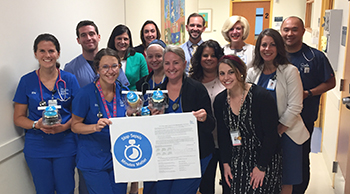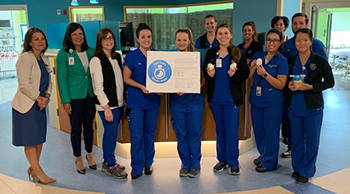-
Services
Featured Specialties
-
Locations
Location Type
-
Patients & Visitors


Hospital leaders are visiting YNHCH units and ambulatory sites, including the Pediatric Emergency Department (top) and Pediatric Intensive Care Unit (bottom), to thank staff and physicians for their successes in detecting and treating sepsis early.
Three years after joining a national effort to improve sepsis outcomes, Yale New Haven Children’s Hospital is celebrating major successes in the detection and early treatment of the potentially deadly condition.
Cynthia Sparer, Yale New Haven Hospital senior vice president, Operations, and YNHCH executive director, and Marianne Hatfield, RN, vice president, Patient Services, Children’s Hospital and Women’s Services, were among the leaders who visited units throughout YNHCH to personally thank staff and physicians for their hard work. Successes include an 18 percent increase in recognizing sepsis patients, 10 percent decrease in the amount of time it takes to begin intravenous antibiotic treatment and 6 percent decrease in the number of days patients spend in the hospital due to sepsis.
“This is the result of your making changes in your practice to save lives,” Sparer told Pediatric Emergency Department staff during a Sept. 5 visit.
Since joining the national Children’s Hospital Association’s Improving Pediatric Sepsis Outcomes collaborative in 2016, staff members from multiple disciplines have gotten involved in the effort. Representatives from the Pediatric ED, Pediatric Intensive Care Unit, inpatient units, Pharmacy, Infection Prevention, Information Technology Services and YNHCH Quality and Safety have redesigned care for patients with suspected sepsis.
Improvements include:
“These measures have made a real difference in helping us recognize and rapidly treat early sepsis,” Hatfield said. “But our physicians and staff members have been the driving force in our success.”
“Their willingness to try new approaches, and their highly developed culture of patient safety, have helped us significantly improve our patients’ outcomes,” said Natalie Vinhais-Luysterborghs, RN, performance improvement coordinator, YNHCH Quality and Safety.